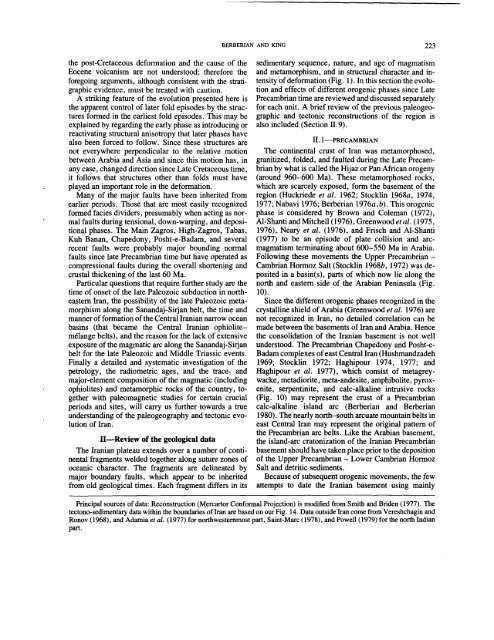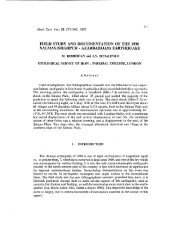PDF COPY - Manuel berberian
PDF COPY - Manuel berberian
PDF COPY - Manuel berberian
Create successful ePaper yourself
Turn your PDF publications into a flip-book with our unique Google optimized e-Paper software.
the post-Cretaceous deformation and the cause of the<br />
Eocene volcanism are not understood; therefore the<br />
foregoing arguments, although consistent with the stratigraphic<br />
evidence, must be treated with caution.<br />
A striking feature of the evolution presented here is<br />
the apparent control of later fold episodes by the structures<br />
formed in the earliest fold episodes. This may be<br />
explained by regarding the early phase as introducing or<br />
reactivating structural anisotropy that later phases have<br />
also been forced to follow. Since these structures are<br />
not everywhere perpendicular to the relative motion<br />
between Arabia and Asia and since this motion has, in<br />
any case, changed direction since Late Cretaceous time,<br />
it follows that structures other than folds must have<br />
played an important role in the deformation.<br />
Many of the major faults have been inherited from<br />
earlier periods. Those that are most easily recognized<br />
formed facies dividers, presumably when acting as normal<br />
faults during tensional, down-warping, and depositional<br />
phases. The Main Zagros, I-Iigh-Zagros, Tabas,<br />
Kuh Banan, Chapedony, Posht-e-Badam, and several<br />
recent faults were probably major bounding normal<br />
faults since late Precambrian time but have operated as<br />
compressional faults during the overall shortening and<br />
crustal thickening of the last 60 Ma.<br />
Particular questions that require further study are the<br />
time of onset of the late Paleozoic subduction in northeastern<br />
Iran, the possibility of the late Paleozoic metamorphism<br />
along the Sanandaj-Sirjan belt, the time and<br />
manner of formation of the Central Iranian narrow ocean<br />
basins (that became the Central Iranian ophiolitem61ange<br />
belts), and the reason for the lack of extensive<br />
exposure of the magmatic arc along the Sanandaj-Sirjan<br />
belt for the late Paleozoic and Middle Triassic events.<br />
Finally a detailed and systematic investigation of the<br />
petrology, the radiometric ages, and the trace- and<br />
major-element composition of the magmatic (including<br />
ophiolites) and metamorphic rocks of the country, together<br />
with paleomagnetic studies for certain crucial<br />
periods and sites, will carry us further towards a true<br />
understanding of the paleogeography and tectonic evolution<br />
of Iran.<br />
II--Review of the geological data<br />
The Iranian plateau extends over a number of continental<br />
fragments welded together along suture zones of<br />
oceanic character. The fragments are delineated by<br />
major boundary faults, which appear to be inherited<br />
from old geological times. Each fragment differs in its<br />
BERBERIAN AND KING 223<br />
sedimentary sequence, nature, and age of magmatism<br />
and metamorphism, and in structural character and intensity<br />
of deformation (Fig. 1). In this section the evolution<br />
and effects of different orogenic phases since Late<br />
Precambrian time are reviewed and discussed separately<br />
for each unit. A brief review of the previous paleogeographic<br />
and tectonic reconstructions of the region is<br />
also included (Section 11.9).<br />
II. I--PRECAMBRIAN<br />
The continental crust of Iran was metamorphosed,<br />
granitized, folded, and faulted during the Late Precambrian<br />
by what is called the Hijaz or Pan African orogeny<br />
(around 960-600 Ma). These metamorphosed rocks,<br />
which are scarcely exposed, form the basement of the<br />
region (Huckriede et al. 1962; Stocklin 1968a, 1974,<br />
1977; Nabavi 1976; Berberian 1976a,b). This orogenic<br />
phase is considered by Brown and Coleman (1972),<br />
A1-Shanti and Mitchell (1976), Greenwood et al. (1975,<br />
1976), Neary et al. (1976), and Frisch and AI-Shanti<br />
(1977) to be an episode of plate collision and arcmagmatism<br />
terminating about 600-550 Ma in Arabia.<br />
Following these movements the Upper Precambrian -<br />
Cambrian Hormoz Salt (Stocklin 1968b, 1972) was deposited<br />
in a basin(s), parts of which now lie along the<br />
north and eastern side of the Arabian Peninsula (Fig.<br />
10).<br />
Since the different orogenic phases recognized in the<br />
crystalline shield of Arabia (Greenwood et al. 1976) are<br />
not recognized in Iran, no detailed correlation can be<br />
made between the basements of Iran and Arabia. Hence<br />
the consolidation of the Iranian basement is not well<br />
understood. The Precambrian Chapedony and Posht-e-<br />
Badam complexes of east Central Iran (Hushmandzadeh<br />
1969; Stocklin 1972; Haghipour 1974, 1977; and<br />
Haghipour et al. 1977), which consist of metagreywacke,<br />
metadiorite, meta-andesite, amphibolite, pyroxenite,<br />
serpentinite, and calc-alkaline intrusive rocks<br />
(Fig. 10) may represent the crust of a Precambrian<br />
calc-alkaline island arc (Berberian and Berberian<br />
1980). The nearly north-south arcuate mountain belts in<br />
east Central Iran may represent the original pattern of<br />
the Precambrian arc belts. Like the Arabian basement,<br />
the island-arc cratonization of the Iranian Precambrian<br />
basement should have taken place prior to the deposition<br />
of the Upper Precambrian - Lower Cambrian Hormoz<br />
Salt and detritic sediments.<br />
Because of subsequent orogenic movements, the few<br />
attempts to date the Iranian basement using mainly<br />
Principal sources of data: Reconstruction (Mercartor Conformal Projection) is modified from Smith and Briden (1977).<br />
tectono-sedimentary data within the boundaries of Iran are based on our Fig. 14. Data outside Iran come from Vereshchagin and<br />
Ronov (1968), and Adamia et al. (1977) for northwesternmost part, Saint-Marc (1978), and Powell (1979) for the north<br />
part.







